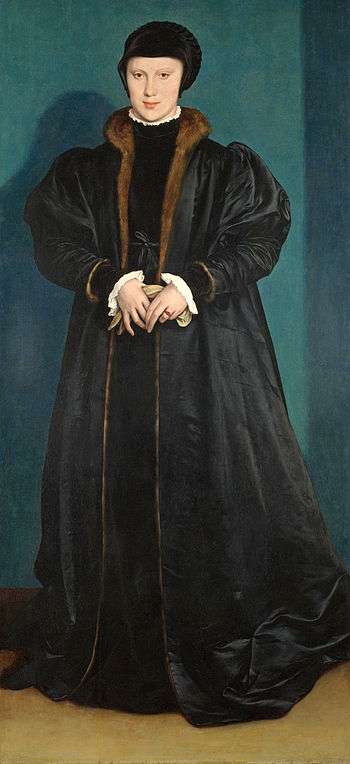Portrait of Christina of Denmark
Portrait of Christina of Denmark was painted with oil on oak panel by Hans Holbein the Younger in 1538. It was commissioned that year by Thomas Cromwell, agent for Henry VIII, as a betrothal painting following the death of the English Queen Jane Seymour. It shows the then sixteen-year-old Christina of Denmark, widowed Duchess of Milan. She was not a great beauty, but had a striking manner and strength of character. Although Henry was taken by her representations, the marriage proposal did not go ahead; not least because she was aware of Henry's earlier treatment of his wives, and said "If I had two heads, I would happily put one at the disposal of the King of England".

Art historian Derek Wilson wrote that the portrait "is the loveliest paintings of a woman [Holbein] ever painted, that is, it is one of the finest female portraits ever painted.[1] It was acquired in 1909 by the National Gallery, London, where it is on permanent display.[2]
Commission

Following the 1537 death of the English Queen Jane Seymour, Holbein was commissioned to paint portraits of noblewomen eligible to marry Henry VIII. Christina was Duchess of Milan, and widowed to Francesco II Sforza, who had died in 1535 when she was just thirteen. Thomas Cromwell sent Holbein and the ambassador Philip Hoby to Brussels to meet with her. He was tasked with providing a straightforward, exact portrait of the girl.[3]
They arrived in Denmark on 10 March 1538, where on the 12th Christina sat for the portrait for three hours between 1:00 and 4:00 pm.[4] Holbein would have been able to converse with her in his native German. That afternoon he made preparatory sketches of her head; the final oil painting was completed at some point shortly after his return to England.
Henry was so taken with the initial colour drawings for the portrait —which showed only her head[3]— that, according to the imperial ambassador Eustace Chapuys, "since he saw it he has been in much better humour than he ever was, making musicians play on their instruments all day long".[1] Various political and practical obstacles related to her close ties with the Lutheran church thwarted the match. On the basis of the drawing, he commissioned that Holbein extend it to a full length oil panel.[3]
Christina herself was against marriage arrangement; she was only sixteen years old and made no secret of her distaste for Henry, who by this time had a reputation around Europe for his mistreatment of wives. She is credited with saying; "If I had two heads, I would happily put one at the disposal of the King of England".[5]
Description
Christina stands in full length in a frontal pose. She is set against a turquoise background, reminiscent of 15th century Burgundian art. She is dressed in black mourning clothes even years after the death of her husband, as was the custom for women involved in a noble Italian marriage. Her black gown is lined with brown fur. She throws a shadow against the wall behind her, a further strip of shadow appears on the right hand side, thrown by an unseen source. Her expression is lively and engaged. She is given bright red lips, whose colour is echoed by the red ring on her fingers.[3] Her youth is conveyed through her half smile, oval face, shy expression and dimples.[5] Although the portrait is filled with indicators of her nobility, she has taken off her gloves, allowing an informal, intimate atmosphere. She is given almost perfect white skin, the tones of which are offset against the black overcoat.[3]
Notes
- Wilson (2006), 250
- "Key facts: Christina of Denmark, Duchess of Milan". National Gallery, London. Retrieved 14 March 2015
- Bätschmann (1999), 192
- "Christina of Denmark, Duchess of Milan". National Gallery, London. Retrieved 14 March 2015
- Wilson (2006), 251
Sources
- Bätschmann, Oskar. Hans Holbein. Princeton University Press, 1999. ISBN 978-0-6910-0516-4
- John Rowlands, Holbein: The Paintings of Hans Holbein the Younger. Complete Edition. Boston, David R. Godine, 1985. ISBN 978-0-8792-3578-9
- Strong, Roy, "Holbein in England". The Burlington Magazine, Volume 109, No. 770, 1967
- Wilson, Derek. Hans Holbein: Portrait of an Unknown Man. London: Pimlico, Revised Edition, 2006. ISBN 978-1-84413-918-7